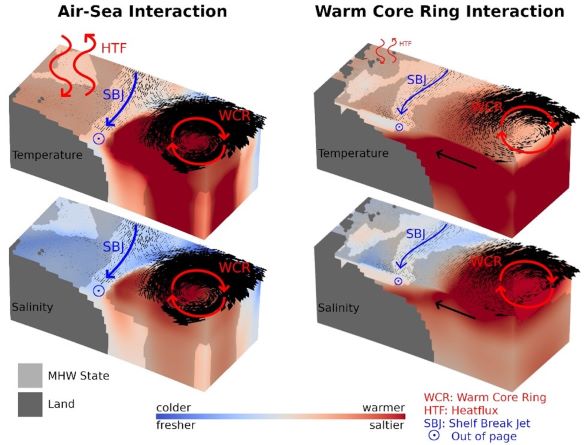Marine heatwaves and their depth structures on the Northeast U.S. continental shelf
Großelindemann, H., Ryan, S., Ummenhofer, C., Martin, T., & Biastoch, A., 2022. Marine heatwaves and their depth structures on the Northeast U.S. continent. Frontiers in Climate, 4, 857937. https://doi.org/10.3389/fclim.2022.857937

Schematic of the two dominating MHW structures and related drivers in the region; shown are 3D fields of temperature and salinity anomalies with shaded MHW state, surface arrows indicate velocities. Image provided by Svenja Ryan.
Marine Heatwaves (MHWs) are ocean extreme events, characterized by anomalously high temperatures, which can have significant ecological impacts. The Northeast U.S. continental shelf is of great economical importance as it is home to a highly productive ecosystem. Local warming rates exceed the global average and the region experienced multiple MHWs in the last decade with severe consequences for regional fisheries. In this study we use output from a high-resolution ocean model, spanning from 1958-2019, to investigate the depth structure of these events on the southern Northeast U.S. continental shelf.
We find highest intensities at around 100m depth with temperatures exceeding the climatological mean by up to 7°C, while surface intensities are typically smaller, around 3°C. Different spatial MHW patterns and drivers are associated with distinct vertical structures. Two case studies provide insight into opposing MHW patterns at the surface and at depth, being forced by anomalous air-sea heat fluxes and Gulf Stream warm core ring interaction, respectively. Investigation of the co-variability of temperature and salinity reveals that over 80% of MHWs at depth (>50m) coincide with extreme salinity anomalies, indicative of the influence of warm, saline water carried by warm core rings. Our results highlight the importance of local ocean dynamics and the need to realistically represent them in climate models.
